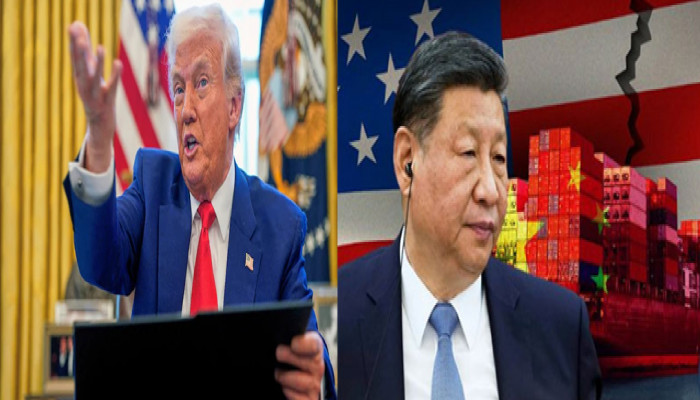Trump escalates trade war with China, rises tariffs to 145%
- In Reports
- 11:27 AM, Apr 11, 2025
- Myind Staff
The White House confirmed on Thursday that U.S. President Donald Trump has significantly raised tariffs on Chinese goods, pushing the total additional tax on most products to 145 percent.
On Wednesday, Trump paused new tariffs on dozens of countries for 90 days. However, he increased pressure on China by raising tariffs on Chinese imports to 125%. This new rate adds to a 20% tariff that was introduced earlier this year, which Trump linked to China’s alleged role in the fentanyl supply chain. Altogether, the total tariffs he has placed on Chinese goods this year now amount to 145%, in addition to older tariffs from previous administrations. The White House then emphasised that the 125% tax on Chinese imports was in addition to the 20% tax that Trump had already announced on Wednesday. Trump defended his tariff measures, which have shaken international markets, during a cabinet meeting, claiming that the US is in "very good shape." "We're very, very happy with the way the country’s running. We're trying to get the world to treat us fairly," Trump said.
Following the announcement, Treasury Secretary Scott Bessent declared, "Do not retaliate, and you will be rewarded," characterising the action as a planned strategy to isolate China while promoting international collaboration. At the same time, China is trying to build relationships with other countries while the US continues to add more tariffs. It seems like China wants to create a united group to pressure the US to back off. However, after a few days of trying, the results are mixed—many countries are not ready to join forces with the main target of Trump’s trade war. China has declined to hold talks and said it would “fight to the end” in the tariff war. In response, Trump raised the tax on Chinese imports to 145%. This was first announced on Wednesday as 125%, but it didn’t include an extra 20% tariff linked to China’s involvement in fentanyl production.
In response, China started charging 84% tariffs on goods from the US, and this began on Thursday. According to Xinhua News Agency, Premier Li Qiang's speech to European Commission President Ursula von der Leyen provided a "positive message to the outside world," demonstrating China's primary priority on Europe.
“China is willing to work with the EU to jointly implement the important consensus reached by the leaders of China and the EU, strengthen communication and exchanges, and deepen China-EU trade, investment and industrial cooperation,” the official Xinhua News Agency reported. Li, the premier, has met with business executives, and Wang Yi, China's foreign minister, has also addressed the Association of Southeast Asian Nations, which has ten members. Li was quoted by Xinhua as stating that China has "already made a full evaluation and is prepared to deal with all kinds of uncertainties, and will introduce incremental policies according to the needs of the situation."
In 2024, China sent $463 billion worth of goods and services to the U.S., according to the U.S. Commerce Department. This made China the third-largest exporter to the U.S., behind Mexico and Canada. At the same time, the U.S. sold a record $199 billion in goods and services to China. America's top exports to China last year included soybeans, airplanes, medicines, and computer chips. In return, the U.S. mainly imported mobile phones, computers, toys, and clothes from China. Although China was the top source of U.S. imports in 2022, trade has recently shifted more toward neighboring countries like Mexico and Canada, due to growing tensions and higher tariffs.
President Trump's sudden move to temporarily relax tariffs for many countries, while still increasing pressure on China, caused big ups and downs in global markets. Investors quickly shifted between risky and safe options, making it one of the most unstable weeks since the COVID-19 pandemic began.
On Wednesday, the S&P 500 index jumped by 9.5%, its biggest one-day increase since 2008. Similarly, Europe’s STOXX index had its strongest rise since March 2020. This short-lived market rally came after Trump announced a "pause" on some tariffs — a surprising move that experts are calling the "Trump Blink." Even though there was some relief, the markets were still nervous. Earlier in the week, the Hong Kong Hang Seng Index had fallen by 13% — its biggest drop since the 1997 handover. Meanwhile, the STOXX 600 and S&P 500 had their sharpest three-day falls since the pandemic. "We are seeing levels of uncertainty and levels of volatility that we haven't seen since the global financial crisis," said George Lagarias, chief economist at Forvis Mazars. "These levels of volatility are not good for financial markets. It risks dislocations."
On Thursday, the market took a downturn again. The S&P 500 dropped by more than 3% as investors sought safer options. Gold prices shot up nearly 3%, hitting a record high, while the US dollar fell to its lowest point in 10 years against the Swiss franc. Treasury yields saw a small drop, but there was some stability thanks to strong demand at a bond auction. The ongoing back-and-forth over trade policies has raised concerns about the wider impact of the US-China tariff war. Even though US consumer prices fell unexpectedly in March, it didn’t provide much comfort to investors, especially with the corporate earnings season starting on Friday with major banks like JPMorgan Chase.







Comments